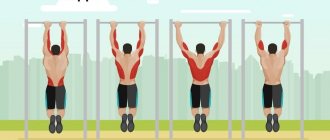The desire to gain a beautiful and sculpted body encourages a person to engage in strength training, but progress in exercise is noticeable for everyone in different ways. For some, it is enough to visit the gym twice or thrice a week to achieve excellent results. Others calmly go to the gym every day, look and feel great, even taking into account the fact that most sources write that the muscles need to be given time to recover. And if you want to achieve your goals in a short time, the issue of the relevance of daily training comes to the fore.
How long does it take for the body to recover?
The human body needs to rest. Otherwise, a state of overtraining will occur, when even the most ideally selected training program will not bring results. The minimum recovery period is one day. Twenty-four hours after training, the body becomes completely ready for the next session.
This condition does not affect everyone, but only affects the following groups of people:
- beginners, that is, those who have recently started training;
- older athletes who are already fifty years old or older;
- amateurs who do not plan to achieve any serious sports goals.
The days between two workouts are necessary for the body to regenerate, produce enzymes, produce new muscle fibers, and gain sufficient energy.
The maximum allowable time that a person can devote to training on exercise machines without rest is three days. This mode without interruption is only suitable:
- actively pumping up the muscles of the arms, legs, and back;
- professional athletes working with heavy weights.
These recommendations should not be taken as absolute truth. Each person’s body is individual, so the specific period for recovery is determined together with experienced trainers and mentors, but if we are talking about independent training, you should not neglect the advice.
Is it possible to train EVERY DAY?
Working out every day: pros and cons, what harm they can cause
Too long and physically exhausting workouts, working with extreme weights, and playing other sports for too long lead to overtraining and harm the body. Clogged muscles and bones will hurt for a few days at best, and several months at worst. Also, excessive training can lead to injury, because the body is not made of iron, each organ and muscle has its own limit. Recovery and treatment in this case will drag on for many weeks, months, or even years, which will lead to a significant setback in progress and a long recovery of the acquired condition.
Frequency of training each muscle group
Increasing muscle volume and definition is a goal that can only be achieved with a regular and continuous training cycle. Long breaks minimize effort, so rest breaks should be determined for your specific case. This does not mean that you can simply choose a certain time yourself, since there are rules that cannot be ignored.
The larger the muscle group, the longer it takes to recover, since it requires much more work and load. Therefore, training that combines small and large muscle groups is incorrect. For example, you cannot train your legs, biceps and shoulders at the same time. This is due to the size of the former.
The legs account for about fifty percent of the total muscle mass of the whole body. And if you combine training of the lower extremities with other groups, this will not bring effectiveness, since it will not be possible to work out either small or large muscles, since the load applied will not be enough to pump in both directions. Such a large muscle group as the legs should be given a separate training day. In addition, it should be taken into account that they will need much more rest than the arm muscles.
Small muscle groups, which include the shoulder girdle, biceps, triceps and others, recover faster, so they can be trained more often. The shoulders, for example, are involved in pumping the pectoral muscles, which in no way contradicts the principle of proper recovery after training.
What are the benefits of daily exercise?
Great mood.
Regular exercise will give you strength and help you maintain a positive attitude. This will motivate you to achieve, which will lead to a feeling of satisfaction.
Relaxation.
Reducing your overall stress will help you relax, improve your sleep quality, and increase your self-confidence.
Photo: istockphoto.com
Socialization.
The social component of group training means that you can get together with friends or new acquaintances and spend quality time together.
"Pure" mind.
Exercise improves cognitive function and helps clear the mind. You can use exercise to develop mindfulness, generate fresh ideas, and explore new ways of thinking.
Healthy lifestyle.
Regular exercise helps prevent or reduce the risk of a number of diseases, such as: - cardiovascular diseases; - type 2 diabetes; - high blood pressure; - metabolic syndrome; - some types of cancer; - arthritis; - decreased appetite; - depression.
In addition, regular exercise promotes weight loss and helps you stay fit.
Not a day without training: what will happen to the body if you exercise every day?
How much rest do beginners need?
People who have just started working out may rest less than their more experienced gym mates. This is due to the training program itself. Experienced bodybuilders lift heavy weights and perform complex variations of exercises, which is why the load on the muscles is much greater.
Beginners don't use their muscles as hard because they simply can't handle the pace. The absence of maximum loads allows them to devote much less time to rest, but only until they become experienced bodybuilders. Those who have recently come to the gym after pumping up large muscles can recover from 1.5 to 2 days, and experienced ones - from 48 to 72 hours.
What happens if you train EVERY DAY?
Recovery for experienced bodybuilders
Takes much longer. Experienced athletes train intensively and intensively. They work at a pace that comes with experience, which greatly increases the load on the body. To increase the effectiveness of training, bodybuilders work on a certain part of the torso at a time, loading each to the maximum.
This split principle allows you to allocate a specific period for individual muscles and load them to the maximum. In addition, this gives you the opportunity to have quality rest for a whole week. Thus, it turns out that training for each group is repeated once a week, when they are fully restored.
Types of exercises
There are a huge number of different types of exercises.
Here are the most common ones:
- Aerobic exercise: Typically the foundation of any fitness program, it involves periods of constant movement. Examples are swimming, running and dancing.
- Strength: Helps increase muscle strength and endurance. Examples include resistance exercises, plyometrics, weight lifting and sprinting.
- Rhythmic gymnastics: Basic body movements performed without the help of machines at an average aerobic pace. Examples are lunges, squats, push-ups and pull-ups
- High-intensity interval training (HIIT): Involves alternating short periods of high-intensity exercise followed by low-intensity exercise or rest.
- camp exercises : Time-controlled, high-intensity exercise routines that combine aerobic and resistance exercises.
- Stability exercises: Strengthen muscles and improve coordination. For example, Pilates, Tai Chi poses and general strengthening exercises.
- Flexibility exercises: Help restore muscles, improve coordination and prevent injuries. Examples of such exercises are yoga or individual muscle stretching movements.
The exercises listed above can be performed individually or in combination. The main thing is that this or that exercise suits and pleases you.
Conclusion: The most common types of exercises are aerobic exercises, strength training, rhythmic gymnastics, HIIT, boot camps, exercises to develop flexibility and stability. You can perform them individually or in combination.
Important points to remember
Arnie, one of the most outstanding bodybuilders in the world, never missed an opportunity to train, and devoted absolutely every free minute to training. Of course, to reach such a high level, he went through quite a long journey, which allowed him to train up to several times a day. It is certainly possible to follow in the footsteps of the famous bodybuilder, but do not forget that Arnie did not immediately become strong.
As a newbie, he went to the gym no more than two or three times a week. Once his body got used to the stress, he increased the number of training days. Any other experienced athlete can do the same, but only when the muscles do not ache or ache. In addition, one should take into account the fact that victories in competitions, fame and money became an excellent incentive for him to maintain his shape.
In the world of professional bodybuilding, competition is quite fierce and every athlete strives to become better. This was the main reason that Arnie had to completely revise his training plan, increasing the intensity and frequency of training. Some bodybuilders take steroids with proteins, which allow them to speed up recovery processes and also quickly adapt to increasing loads.
The key to the success of successful bodybuilders is that they are completely able to concentrate on the training process and not be distracted. They can push themselves to the point of exhaustion even when lifting light weights because they have a clear idea of the result they want to achieve.
Another important point that absolutely all beginners should take into account is that without rest days they train inconsistently, but only three or four weeks before the competition.
Is it possible to train every day from the point of view of specialists?
Frequent heavy training can cause the so-called overtraining syndrome in an athlete. Not a very pleasant event that every gym goer has encountered. This is that feeling when you don't want to train. There is a wild desire to give up on the gym. And in general, life in general is not happy. In this case, you just need to rest. Lie on the couch, ease up on your diet, take a break from everything that stresses you out, within reason, of course. But don’t forget to take a walk in the fresh air. We described overtraining syndrome in more detail in our separate article.
Pain in muscles and joints, fatigue - all these are inevitable consequences, as it sometimes seems, of daily training. But is this really so and what do experts say about this?
- Summarizing all the reviews, we can say that from the point of view, for example, orthopedics, daily training is not a cause for concern. On the contrary, orthopedists believe that strictly dosed physical activity develops the musculoskeletal system. According to orthopedists, even a regular jog is beneficial and safe. But if you have problems with your joints, it is better to switch to another sport, for example, swimming.
- Professional trainers are almost unanimous in their assessment. They believe that a daily increase in heart rate is useful for increasing endurance and strengthening the immune system. Of course, unless we are talking about marathons. Unlike doctors, professional trainers emphasize the importance of variability. For example, do cardio one day, upper body muscles another, and lower body the next. But monotonous programs, in their opinion, can contribute to the appearance of signs of wear.
- Nutritionists say those who exercise every day should adjust their nutrient intake accordingly. Otherwise, in the long run, you will not only lose fat tissue, but also muscle mass.
Training plan
If you are going to become the owner of a beautiful, sculpted body, you need to have a clear training plan and follow this program.
Pumping a specific muscle group every seven days
It might look like this:
- Monday - chest;
- Tuesday - back;
- Wednesday - rest;
- Thursday - legs;
- Friday - shoulders.
They rest on Saturday and Sunday. Thus, it turns out that only one large muscle is worked during the week, and then it is restored over the next week. The main thing is that specific muscles are loaded on each day.
The load on the muscle should be maximum. Otherwise, the training day will be wasted, and this will slow down the development of pumping. You can't strain yourself too much. It is necessary to maintain a good balance in order to be fully restored and full of energy before the next lesson.
Torso pumping
Carried out three times a week - Monday, Wednesday, Friday. The entire torso is loaded. The remaining days are devoted to rest. This training scheme creates a good load, but no stress. With a three-time training scheme for the entire torso, you should do from 3 to 4 sets for each muscle group within one session. In other words, the total number of approaches is 9-12.
Two-day training plan per week
On Monday and Thursday the upper torso is pumped, and on Tuesday and Friday the lower torso is pumped. Wednesday, Saturday, Sunday are days off.
It turns out that each muscle group has a separate training day. This is an intermediate option between the first and second training schemes, which allows you to avoid both excessive and low loads.
The number of approaches for each category of exercise varies from 5 to 6. The pace is chosen moderate, which allows you to maintain frequency and volume without any extremes. The total number of sets per week is 10-12.
Is it possible to train every day? 5 DETERMINING FACTORS!
How to get the most out of sports
To make sports fun and produce results, physical exercise alone is not enough. In addition, the following conditions must be met
:
- A sound and healthy night's sleep of at least 7-8 hours daily.
- The same daily routine (work, rest, training, sleep at the same time, so that the body gets used to it and there is no stress for it).
- Proper nutrition (required caloric content of food, taking vitamins, healthy eating, varied diet).
- No bad habits. No smoking, minimum or complete abstinence from alcohol.
- Avoiding stressful situations, focusing on the positive, attracting the good and the good.
Sports are good in moderation! Life wisdom says that any activity is useful if you do it in moderation. The same applies to sports. Besides it, there are enough cool and interesting things in life that bring joy and pleasure. Therefore, you should not get hung up on sports and do it every day, unless you are a professional athlete.
Is it possible to exercise every day? What is important to consider in training? Training Tips!











